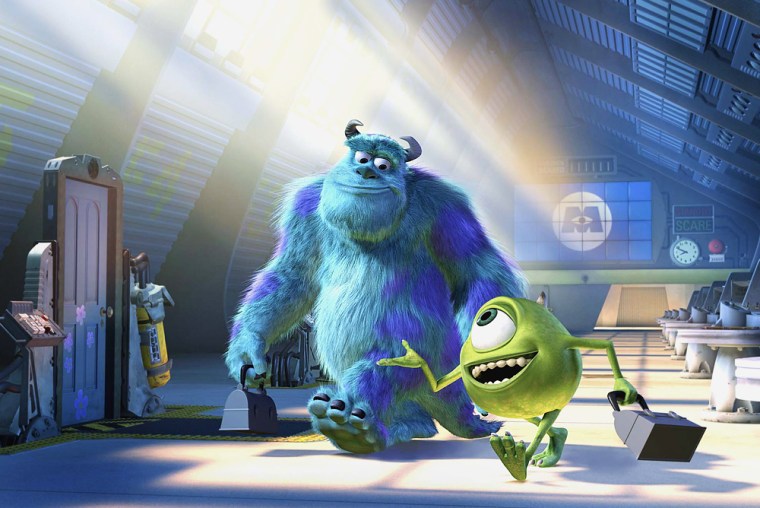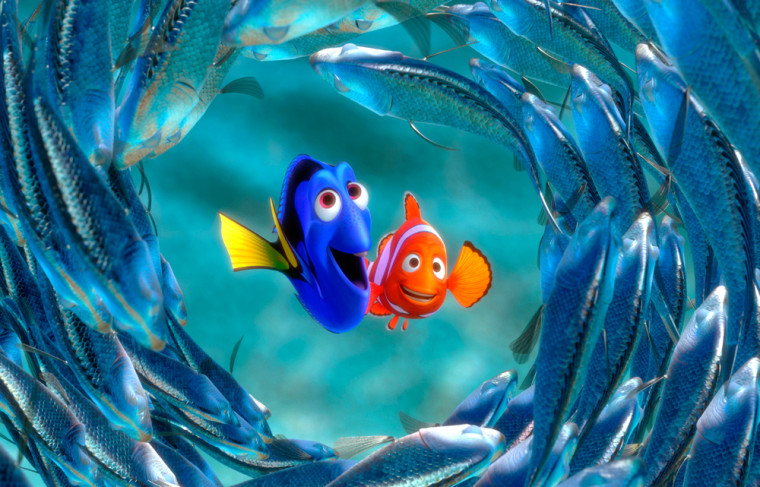Their movies are for kids, but Disney and Pixar are headed toward a parting of ways that’s decidedly adult. When their partnership agreement dissolves in 2005, the aging House of Mouse is the one that’s going to take it on the furry little nose.
“It’s a shame that Disney won’t be participating in Pixar’s future successes,” Pixar CEO Steve Jobs said back in January. Audiences may not care about who gets a cut of the Pixar pie, but to Disney and its competitors, it’s a multi-billion dollar proposition.
If the companies’ past track record is any indication, potential future profits will skyrocket — to quote “Toy Story’s” Buzz Lightyear — to infinity, and beyond. Over just nine years, Disney and Pixar have teamed up on five flicks, which earned a combined $2.5 billion dollars at the box office and sold more than 150 million DVDs and videos worldwide. That’s a lot of green. And cyan and magenta and indigo — and the millions of other colors that make up these high-tech animators’ electronic palettes.

For a rundown of the two companies’ animated offspring, take a look at your kid’s bedspread, toy box and video shelf. Their collected works read like a who’s who of recent animated classics: “Toy Story,” “Toy Story 2,” “A Bug’s Life,” “Monsters, Inc.,” and “Finding Nemo,” which was, until DreamWorks’ “Shrek 2” lumbered into theaters, the highest-grossing animated film of all time.
Now “The Incredibles” is set to continue Pixar’s dominance of the animated movie market — an industry that was, once upon a time not too many years ago, on the verge of fading quietly away.
Has Disney lost its magic touch?From “The Fox and the Hound” to “Oliver & Company” to “The Black Cauldron,” the 1980s saw the Walt Disney Company releasing a string of unimpressive animated features that kept safely within the limitations of standard ink-and-paint production — sparking talk that the industry was on its last legs. Disney rebounded in the late ’80s and early ’90s by pushing the envelope of traditional animation with contemporary classics like “Beauty and the Beast,” “The Little Mermaid” and “The Lion King.”
In 1995, “Toy Story” — the first joint venture between Disney and upstart Pixar Animation Studios — breathed new life into the fading animation market, but not without a price. In a way, the Pixar partnership — and its subsequent popularity with audiences — was instrumental in fostering the public’s increasing disinterest in classical animation. Launching the new technology with a movie as instantly likable as “Toy Story” no doubt quickened traditional ink-and-paint animation’s demise. Thankfully, Pixar has embraced its role as high-tech pioneer, and turned out a new generation of classics, films that dazzle with not only eye-popping graphics, but also flesh-and-blood characters that kids — and adults — care about.
How? Ironically, Pixar has taken a cue from their soon-to-be former partners. The upstart’s movies are reminiscent of early Disney, utilizing many of the same groundbreaking characteristics that Walt & Co. exhibited in its formative years. Early classics like “Snow White and the Seven Dwarfs,” “Pinocchio” and “Cinderella” were spectacular, character-driven gems, ignited by eye-popping graphics and sweeping tales of adventure and romance. Recent Pixarless Disney outings like “The Emperor’s New Groove,” “Brother Bear” and “Treasure Planet”? Not so much. Disney seems to have lost its Midas touch.
Pixar’s appealPixar, on the other hand, has found a way to spin high-tech gold. Certainly amazing animation is foremost in Pixar’s movies’ appeal, at least on the surface. The computer-generated worlds that unfurl on the screen effortlessly suck in an audience with their photorealistic rendering and spectacular, gee-whiz technology.
But the actual heart of a Pixar production is the “real” characters that populate its CG sets. They may be built of bits and bites, but these characters are as alive as celluloid creations can be, with real-life troubles, hopes, dreams, reactions and relationships.

In “Toy Story,” the bond between Woody and Buzz Lightyear is genuine — even lifelike. (Yes, I realize I’m talking about a stuffed cowboy doll and an action figure. And computer-generated ones at that.) They drive each other batty, but the audience gets a sense of the friendship beneath their banter. Same with Mike Wazowski and Sulley in “Monsters, Inc.” The relationship shared by Nemo and his dad, Marlin, is as multi-faceted as the ones most fathers and sons go through, no matter whether they’re animated fish or flesh-and-blood people.
Pixar seems to treat its characters almost like actors, and crafts memorable stories for them to act in and sharp lines for them to deliver. That focus on “humanity” is dramatically reflected in the great care the creators take with their sidesplitting end credits. You almost really believe these bugs and monsters are making bloopers. In contrast, many recent Disney characters have emerged as, uh, two-dimensional. Audiences never get to know them, no matter how much they leap around, sing or swashbuckle.
The Pixar roller coaster ride provides plenty of chills, but not too many to scare off the littlest audience members. Adventures are simple enough for kids to follow, yet thrilling enough to hold adults’ attention. (They’re often basic enough to be summed up in a few words. “Finding Nemo.” There.) And the sharp, witty writing allows Mommy to consent to multiple viewings without wanting to gnaw off her arm and hit herself over the head with it.
Pixar also scores points for tackling iconic subject matter that appeals to a broad audience: So far, they’ve focused on toys, bugs, monsters and fish. In 2005, it’ll be cars. And this year, superheroes.
That’s ‘Incredibles’“The Incredibles” looks to be somewhat of a departure for Disney/Pixar. Gone are the plump talking caterpillars and whimsical toy dinosaurs. This is life-and-death stuff, with explosions and danger and top-secret intrigue. Instead of looking for a lost fish or tracking a kidnapped toy, these heroes are battling a baddie bent on world domination.
Director Brad Bird, an animation veteran (“The Simpsons,” “Iron Giant”) in his first time in the Pixar driver’s seat, no doubt understands how important it is to capture what’s exciting about comic books and cartoons. Based on the early teaser trailer, where Mr. Incredible struggles to buckle his too-tight belt, Bird also gets how crucial it is to incorporate a hefty dose of Pixar-brand humor into the mix.
Most important, he seems to realize that beneath the tights and bulky muscles, “The Incredibles” is really about family. A superpowered family, but a family nonetheless. And that fits right in to what Pixar has delivered in the past, and what its audiences continue to crave — heartwarming, thrilling stories about families and friendship.
The futurePixar has evolved from a gaggle of struggling computer geeks into a heavy-duty player in the entertainment industry, and, with a future that’s as bright as a movie projector’s flickering light, the company has never been more attractive to potential partners. Maybe it’ll hook up with Warner Brothers, 20th Century Fox or Sony. Or maybe Disney and Pixar will ultimately kiss and make up.
No matter which road it follows, Pixar is the one that’s going to emerge from this potentially nasty breakup with a bunch of suitors offering flowers and chocolates — and millions and millions of dollars. The smartest potential partners will pony up a considerable dowry, giving Pixar the box office receipts and licensing revenue it argued about with Disney. The stakes are too high — and the potential profits are too great — to monkey around with minutiae. Moviegoers are going to gobble up whatever Pixar delivers, and its distribution partner will reap the rewards.
The bottom line is that Pixar creates pixilated characters that are real, even more so than many of their flesh-and-blood counterparts. And for the people waiting in line to buy tickets to Pixar’s next animated feature, that’s more important than some Mickey Mouse tiff.